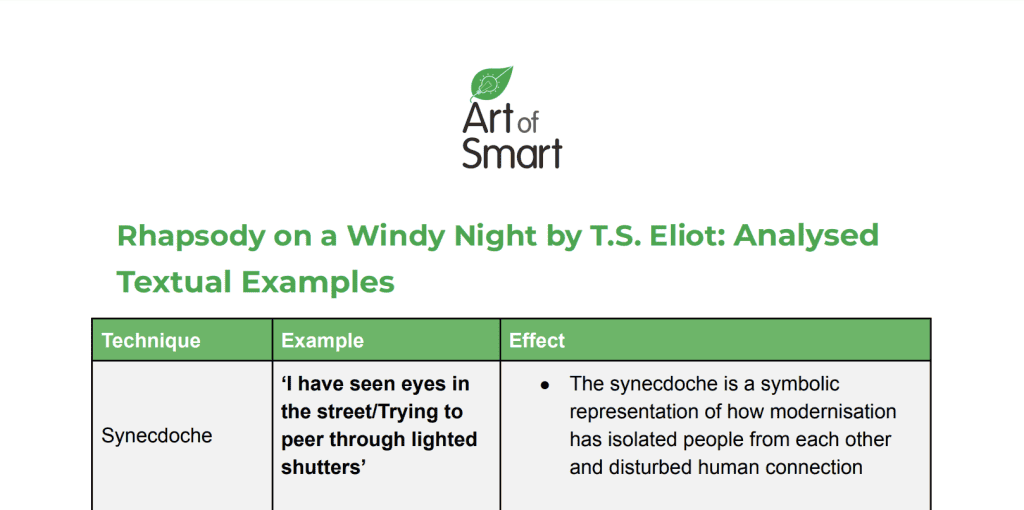Are you studying ‘Rhapsody on a Windy Night’ for HSC English but have no idea where to start for your analysis?
Look no further because we’ve got you covered!
We’re here to guide you through the analysis, context, key themes and a TEE table of ‘Rhapsody on a Windy Night’ as well as provide you with a step-by-step guide on how to perfect your analysis.
So, what are you waiting for? It’s time to ace your ‘Rhapsody on a Windy Night’ analysis! — let’s get to it!
Summary of Rhapsody on a Windy Night by T.S. Eliot
Context
Themes Explored in Rhapsody on a Windy Night
Studying this Text for Module B: Critical Study of Literature
Analysis of Rhapsody on a Windy Night by T.S. Eliot
Summary of Rhapsody on a Windy Night by T.S. Eliot
Written in Paris circa 1911, ‘Rhapsody on a Windy Night’ is known as one of T.S. Eliot’s most difficult poems to deconstruct. The central motif of memory guides the poem as it follows the speaker’s increasing isolation in a modernising world.
Divided into six stanzas, ‘Rhapsody on a Windy Night’ is a lyric poem in free verse without a distinct persona or consistent rhyme scheme. The poem is considered to be Eliot’s emotional and psychological response to modernisation as he evokes disturbing realities that distort time, memory, and human connection.
‘Rhapsody on a Windy Night’ is influenced by Henri Bergson’s philosophy that our perceptions of the world are drawn from our social context and thus influencing how we experience memories. Several French symbolists, most notably Charles-Louis Phillipe, have influenced the fragmented imagery of a a sordid and grimy urban environment in Rhapsody on a Windy Night.
Context
T.S. Eliot was an American-English modernist poet who wrote about the changing pace of modern society and its clash with the stability of tradition. Raised in the United States, Eliot moved to England at the age of 25 in 1914 and became interested in philosophy and religion in the late 1920s. He was a mentee of Ezra Pound, a leading figure in the early modernist poetry movement.
The modernist context of T.S. Eliot’s poetry is characterised by experimentation with traditional poetry subjects, techniques and expression.
The early 20th century was marked by changes in art, politics, science, culture and religion that reflected increasing urbanisation, industrialisation, and technological advancements of the time. Exploring multiple themes, often without a coherent narrative, the different variations of modernism in Eliot’s work include:
- Imagism: Clear images through sharp language
- Symbolism: Symbols of ideas for audiences to interpret
- Realism: Unembellished depictions of the world
- Naturalism: Extreme realism about the psyche
- Impressionism: Simple observations of reality
- Expressionism: Confessional probing of an individual
- Surrealism: Fusing reality and unconsciousness
Studying another poem by T.S. Eliot? Check out our ‘The Hollow Men’ analysis!
Themes Explored in Rhapsody on a Windy Night
As a poem, there are several structural, contextual, and language features that aid in deconstructing the major themes of the text. ‘Rhapsody on a Windy Night’s’ use of symbolism, imagery, repetition and tone is closely connected to the textual integrity and significance of the poem’s enduring themes.
Below are some of the key themes from ‘Rhapsody on a Windy Night’ that make for a strong starting point to structure your analysis:
Memory
Controlled by the industrialised environment, memory is used as a metaphysical representation of truth that has become increasingly blurred and difficult to locate in modern society.
Time
In ‘Rhapsody on a Windy Night’, time plays a significant role in directing action. Namely, it explores how the passage of time informs our experiences and dissolves memories.
Alienation
The superficiality and harshness of the urban environment explores the modern man’s isolation in an evolving society that disintegrated the relationship between natural world and human connection.
Studying this Text for Module B: Critical Study of Literature
In Module B, students develop detailed analytical and critical knowledge, understanding and appreciation of a substantial literary text. Through increasingly informed and personal responses to the text in its entirety, students understand the distinctive qualities of the text, notions of textual integrity and significance.
Students study one prescribed text. Central to this study is the close analysis of the text’s construction, content and language to develop students’ own rich interpretation of the text, basing their judgements on detailed evidence drawn from their research and reading.
In doing so, they evaluate notions of context with regard to the text’s composition and reception; investigate and evaluate the perspectives of others; and explore the ideas in the text, further strengthening their informed personal perspective.
Students have opportunities to appreciate and express views about the aesthetic and imaginative aspects of the text by composing creative and critical texts of their own. Through reading, viewing or listening they critically analyse, evaluate and comment on the text’s specific language features and form.
They express complex ideas precisely and cohesively using appropriate register, structure and modality. They draft, appraise and refine their own texts, applying the conventions of syntax, spelling and grammar appropriately.
Opportunities for students to engage deeply with the text as a responder and composer further develops personal and intellectual connections with the text, enabling them to express their considered perspective of its value and meaning.
Link #1: Students understand the distinctive qualities of the text, notions of textual integrity and significance.
To analyse the textual integrity and significance of T.S. Eliot’s work, students will look at how the distinct qualities of the text, including its form, ideas and language, produce an integrated whole related to its value and meaning. In Eliot’s poetry elements that contribute to textual integrity of his work and create an enduring relevance include:
- Consistency of tone as pessimistic and hopeless
- Universal themes relevant to the human condition e.g. alienation
- Ambiguous and obscure meaning
Want a refresher on the basics of poetry analysis? Check out our poetry guide!
Link #2: Evaluate notions of context with regard to the text’s composition and reception
To examine the enduring relevance of T.S. Eliot’s work throughout various contexts, it’s important to take a look at how time, place, society, culture and politics have informed the construction of Eliot’s texts and how this influences the poem’s reception over time.
We’ve noted that the modernisation of the early 20th century saw radical transformations across all areas of society — most notably the human experience. In turn, the societal upheaval and disconnection reflected in T. Eliot’s work had an influential role in paving the path for the modernist poetry movement and is one of the most significant works of the early 20th century.
How to Analyse Rhapsody on a Windy Night in 3 Steps
A common mistake that students encounter when attempting to enter an essay question is starting with their thesis. A better approach is to use your analysis as the starting point. Analysing your text is a great way to gain an in-depth understanding of its construction, content and language before you begin to answer anything about it.
After you’ve analysed your text, you will be able to build on its themes and construct a strong thesis! We’re going to walk you through creating an analysis for ‘Rhapsody on a Windy Night’ in three simple steps!
Step 1: Choose your example
When choosing your example, a pro tip is to search for a line that contains a technique. Techniques are the key to helping you dig deeper into what meaning the composer is trying to convey.
We’ve chosen two quotes that both use the moon as symbolism:
‘Along the reaches of the street/ Held in a lunar synthesis’
And
‘The moon has lost her memory/ A washed-out smallpox cracks her face’
Step 2: Identify your technique(s)
When trying to locate a technique within your example, the best method is to identify a technique that will allow you to uncover a deeper subtext of your work and elevate your argument and analysis.
Rather than referencing simple language techniques like alliteration and rhyme, try searching for techniques that unveil symbolic meanings like metaphors, motifs, allusions, and personification. To show off your analysis skills to the marker, it’s always better to identify and explain multiple techniques in your quotes rather than rely on one.
We have identified 3 techniques in the two quotes above: symbolism, pathetic fallacy and imagery.
Step 3: Write the analysis
When you write your analysis, the key focus should be on the effect of the quote. Simply labelling what technique you’re using is not proper analysis and will award you minimal marks. Technique labelling would look like this:
The symbolism of the moon as having mystical powers is shown in the lines, ‘Along the reaches of the street/ Held in a lunar synthesis’. The pathetic fallacy of the moon as an old and diseased woman is shown through the imagery in the lines, ‘The moon has lost her memory/ A washed-out smallpox cracks her face’.
Instead of labelling, we need to flesh out how each technique allows a closer reading of the text. Firstly, the symbolic associations with the moon as having mystical and irrational properties represents how society is losing its vitality and rationality amid rapid urbanisation and industrialisation.
Pathetic fallacy attributes agency to the moon and genders it as an old woman to infer madness and weariness of modern society. The decaying imagery of ‘washed-out smallpox’ represents the symbolic destruction of the natural world. So, if we adjusted our analysis to avoid technique labelling, it would look like this:
The symbolic associations with the moon as possessing mystical and irrational properties is represented in the line, ‘Along the reaches of the street/ Held in a lunar synthesis’, reflecting how rapid urbanisation and industrialisation has transformed society into one without vitality and rationality. Through the use of pathetic fallacy in the line, ‘The moon has lost her memory’, the attribution of agency to the moon as an old woman is symbolic of the madness and weariness associated with modern society. The decaying imagery of the moon, ‘A washed-out smallpox cracks her face’, is representative of the symbolic destruction of the natural world.
Need some help analysing other texts?
Check out other texts we’ve created guides for below:
- Macbeth
- One Flew Over the Cuckoo’s Nest
- Fever 103
- The Pedestrian
- Away by Michael Gow
- Good Night and Good Luck
- King Lear
- Frank Hurley: The Man Who Made History
- Mabo
- Things Fall Apart
- Shafana and Aunt Sarinnah
- Photograph 51
- ‘Red’ by Ted Hughes
- Run Lola Run
- Rainbow’s End
Are you looking for some extra help with your analysis of Rhapsody on a Windy Night by T.S. Eliot?
We have an incredible team of English tutors and mentors!
We can help you master your analysis of Rhapsody on a Windy Night by taking you through the summary, context and themes. We’ll also help you ace your upcoming English assessments with personalised lessons conducted one-on-one in your home or online!
We’ve supported over 8,000 students over the last 11 years, and on average our students score mark improvements of over 20%!
To find out more and get started with an inspirational tutor and mentor, get in touch today or give us a ring on 1300 267 888!
Ashley Sullivan is a Content Writer for Art of Smart Education and is currently undertaking a double degree in Communications (Journalism) and a Bachelor of Laws at UTS. Ashley’s articles have been published in The Comma and Central News. She is a film, fashion and fiction enthusiast who enjoys learning about philosophy, psychology and unsolved mysteries in her spare time.







